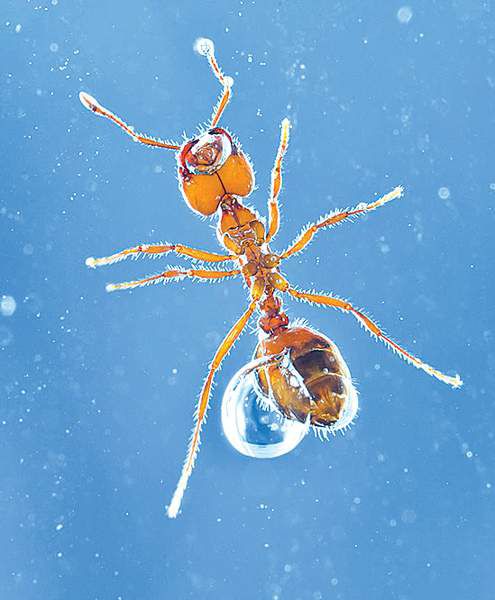In floods, teamwork keeps fire ants afloat
Published 5:00 am Tuesday, April 26, 2011

- An air bubble helps keep a fire ant afloat. When a colony of ants is stranded on water, the ants lock legs and jaws to form a raft kept afloat by the buoyancy of their collective bubbles.
Congress could learn a thing or two about teamwork from Solenopsis invicta, the dreaded fire ant.
When swept up by a flood, a colony of the critters — thousands of them — will save themselves by joining forces and forming a raft. They pile together and lock arms, legs and jaws.
Trending
So bound, an ant raft can survive for months, sailing off to new lands.
Engineers studying animal oddities now report that together, the ants aren’t just stronger. They’re more buoyant. Airtight, even.
“Water does not penetrate the raft,” said Nathan Mlot, a mechanical engineer at Georgia Institute of Technology and lead author of the ant-raft report published in Monday’s Proceedings of the National Academies. Even the bottom layer of ants stays dry, he said.
But why? Individual fire ants, when dropped in water, struggle and flail, but a close inspection reveals a thin layer of air clinging to the swimmer. It’s a self-supplied flotation device.
The uneven, hairy surface of the ant’s skin explains this phenomenon. Bumpy, hirsute, or otherwise rough surfaces repel water because of something called the Cassie-Baxter law of wetting. And unlike the McCain-Feingold law of campaign finance reform, Cassie-Baxter always applies.
This physical law states that as a surface gets rougher, water has a tougher time touching it. Duck feathers also repel water because of their tiny bumps.
Trending
Although individual fire ants have been thoroughly studied in the lab, until now no one had bothered to figure out how ant rafts float.
So Mlot and his colleagues gathered up fire ants from the urban wilderness of Atlanta. The ants’ floating prowess makes them easy to collect. Just scoop up an ant mound, dump it in a bucket of water and collect the entire population as it pops to the surface.
Back in the lab, Mlot deposited colonies of 500 to 8,000 ants in large beakers. When gently swirled, each colony spontaneously formed a sphere.
Mlot dropped these spheres into water, and the amazing social behavior of ants became evident. The ants on top of the ball crawled down to the water and grabbed onto other water-level compatriots. The next layer of top ants then crawled to the edge, and so on. In about a minute and a half, each ant-sphere flattened into a dome, then flattened further into a pancake shape — a raft.
When the engineers flash-froze one ant raft with liquid nitrogen and scanned it under a microscope, they saw ants clinging to one another every which way — legs on legs, jaws on legs, jaw on jaws. They also counted about 2 1/2 layers of ants per raft.
This togetherness pushes each ant’s individual air bubble against the next ant’s bubble. The bubbles join, protecting the whole raft.
“If water can’t come into contact with one ant, or the next, or the next, air can’t get through,” said Mlot.
The rafts are so buoyant that the engineers had to push them eight inches underwater before any water leaked through. As the rafts submerged, the ants pulled together even more tightly, working together to maintain their water-tight communal craft.
The rafting behavior likely evolved because fire ants hail from oft-flooded regions of Brazil and Argentina, said Alexander Wild, an ant researcher at the University of Illinois at Urbana-Champaign. “This is a secret to their success,” he said of the biting pests that invaded the southern United States decades ago. “They can come out of a flood and be the first ants in.”
Other species of ants huddle together to make structures, the most famous being the giant army ants of South America, which form large bivouacs, or living nests, each night. But only fire ants make rafts.
When building these structures, no single ant is in charge. Yet what looks like chaos is really communal organization. The ants act as one, becoming what entomologists call a super-organism.
And the lesson for Congress, which recently wound itself up in knots simply trying to keep the government afloat?
“These ants hang in there and figure out a way to get the job done,” said Michael Raupp, an entomologist at the University of Maryland at College Park. “It’s another fascinating example of altruistic behavior, ants acting as super-organisms. Insects doing insect things.”







